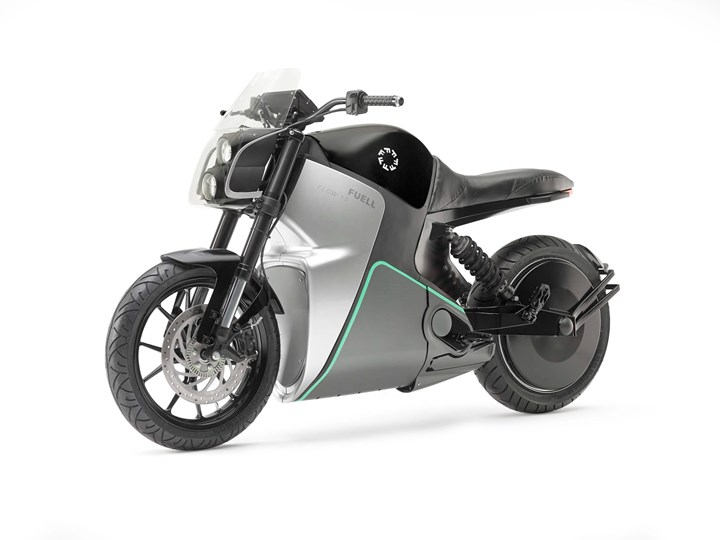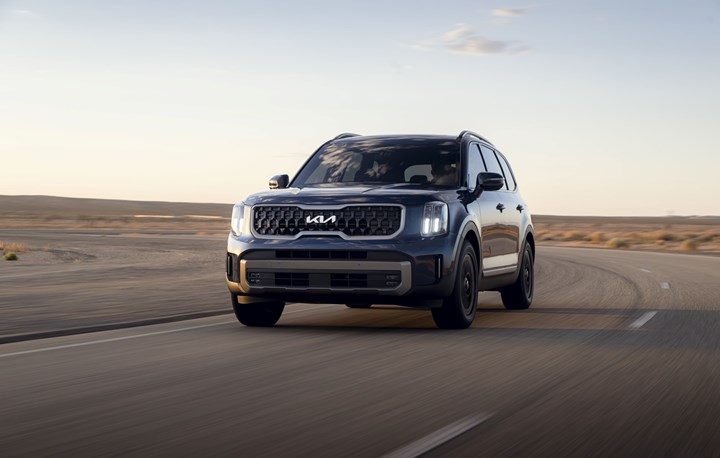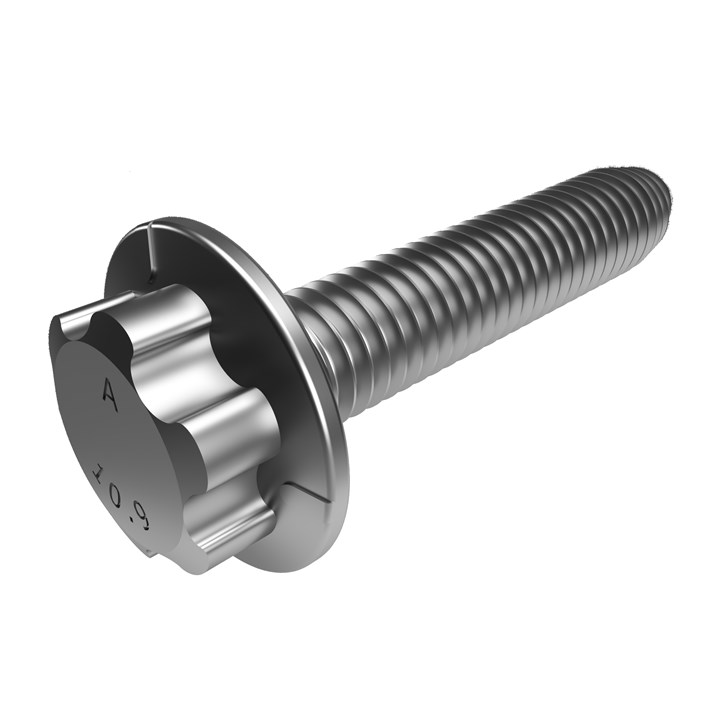on Buell's New Bike, Residual Values, Charging Challenges, & More
Erik Buell goes electric. . .which OEMs are building vehicles with strong residual values. . . cybersecurity and charging. . . a retro Chevy truck EV. . . Purdue engineers develop autonomous transport that considers disabled riders from the start. . . fasteners and weight savings. . .Genesis GV60 review. . .
Erik Buell Goes Electric

Erik Buell’s clever electric bike is features a modular design so the owner can obtain updates over time. (Image: Fuell)
In the world of motorcycles, there are few people who garner more respect than Erik Buell. He is known for racing bikes. He is known for innovations, like using a hollow aluminum frame for structure and fuel containment. He is known for uncompromised performance in his execution.
Buell:
“There is no argument that currently, with battery technology as it stands, gas-powered motorcycles designed and used in traditional ways seem to be a more rational choice.”
Which seems to be a strange thing for a guy who is now the chief technology officer of Fuell, a company that is in electric mobility. . .including motorcycles.
Buell continued:
“Yet when you take into account the growing restrictions in city centers, and you focus on the duty cycles of urban/suburban use, the relevance of new types of urban scooters and urban motorcycles makes a lot more sense. Even more so when you integrate high voltage systems into your design, to make them compatible with automotive fast charging stations already installed in those areas.”
Fuell has developed the Fllow, an electric bike for urban and suburban use.
Radical Design
Buell said the Fllow has “the most radically innovative chassis design I’ve ever done, and from steering head to rear wheel is filled with new design concepts that no one has done before.”
For example, the battery pack—10-kWh lithium-ion cylindrical cell array in a magnesium housing—is structurally the main part of the chassis.
A proprietary transverse flux motor is integrated into the rear wheel. It provides 47 hp, continuous.
- The bike has an urban range of an estimated 150 miles.
- It has a maximum speed of 85 mph and can go from 0 to 62 mph in 3.5 seconds.
- It weighs less than 400 pounds.
- It is said to have 60% fewer parts than a gas-powered equivalent and can be assembled in 40% of the time.
Another interesting aspect is that the Fuell has a modular design so that things like the battery, fast-charging sockets and rear wheel motor can be replaced to upgrade the vehicle over time.
Price: $11,995.
Deliveries are expected in early 2024—but the company needs 3,000+ reservations to launch a crowdfunding campaign, so if you’re interested, go here.
///
Assessing Vehicular Value

2023 Kia Telluride achieved the ALG award in the midsize three-row SUV category. (Image: Kia)
One of the key factors many vehicle shoppers enter into their actual or mental spreadsheets is the value of the vehicle when it is time to sell it. Yes, it may seem odd to put getting rid of the vehicle ahead of acquiring it, but residual values are important to the purchase decision.
After all, it means money.
ALG is the J.D. Power division that is the industry go-to when it comes to residual value projections. It takes into account a variety of factors from the brand value to the product competitiveness to transaction prices to days-to-turn to. . . .
While ALG residual value projections are extremely important in the leasing world, where mass numbers of vehicles are involved, they are no less important to the individual who is going to buy her or his singular vehicle.
One could also make the argument that build quality has a role to play in residual value: Something that is good in year three is going to have higher value than something that is proven to be unreliable after year one or two.
So there is more than one upside to vehicles with high residual values.
The Performers
Last week the J.D. Power 2023 U.S. Residual Value Awards were announced.
That Honda received the ALG award for overall mass-market vehicles isn’t particularly surprising.
Nor is Lexus taking it for the premium brands gasp-evoking.
It isn’t surprising that Honda received four model-level awards:
- Compact car: Civic
- Small SUV: HR-V
- Midsize SUV (2 row) Passport
- Midsize van: Odyssey
It isn’t surprising that Toyota tied Honda with four awards:
- Premium compact sports car: GR Supra
- Off-road utility: 4Runner
- Large light duty pickup: Tundra
- Midsize pickup: Tacoma
What is surprising is how well Kia did.
Kia received five model-level awards.
- Small car: Rio
- Midsize car: K5
- Micro SUV: Soul
- Compact SUV: Sportage
- Midsize SUV (3 row) Telluride
Which is to say that ALG evidently sees some solid style, engineering and brand value in vehicles from a company that has been selling cars in the U.S. only since 1992.
Eric Lyman, vice president of ALG, said, “Kia has become a force to be reckoned with.”
Indeed.
One More Thing
What, you may wonder, of the Traditional Domestics and the ALG awards?
GM has both the Chevrolet Bolt EV and the Silverado 2500 HD and the GMC Hummer EV pickup.
Stellantis has the Jeep Wagoneer.
Ford didn’t make the list.
If you look at the categories taken by Honda, Toyota and Kia, it really ought to make some people in southeastern Michigan take notice.
While the new vehicle sales situation continues to be distorted by supply chain and chip issues, at some point this is going to be resolved. Which puts companies like Kia, Toyota and Honda in excellent positions going forward.
///
As If EV Charging Doesn’t Already Have Challenges
“Can the grid be affected by electric vehicle charging equipment? Absolutely. Would that be a challenging attack to pull off? Yes. It is within the realm of what bad guys could and would do in the next 10 to 15 years. That’s why we need to get ahead of curve in solving these issues.”—Brian Wright, cybersecurity expert, Sandia National Laboratories
Wright and colleagues at Sandia are researching the potential impacts of cyberattacks on EV charging equipment and sensors.
In a paper published in Energies they write:
“Cybersecurity researchers have recently identified several vulnerabilities that exist in EVSE [electric vehicle supply equipment] devices, communications to electric vehicles (EVs), and upstream services, such as EVSE vendor cloud services, third party systems, and grid operators. The potential impact of attacks on these systems stretches from localized, relatively minor effects to long-term national disruptions.”
While there are certainly issues related to things like credit-card skimming, as there are at your local liquid fuel station, seems like there is a bigger potential impact (i.e., the effects on the grid, not just your credit card or vehicle or EV charge station).
According to reporting by Sandia’s Mollie Rappe, Sandia’s cyber experts are working with those at Argonne, Idaho and Pacific Northwest national labs, as well as from the National Renewable Energy Laboratory, and others.
Seems like they’re bringing out the really smart minds for this.
And you thought the chargers that didn’t work when you pulled up to get a charge were a problem.
///Chevy 3100 Resto-Mod Goes Electric

Cybertruck or Kindred 3100? (Image: Kindred)
The light- and medium-duty pickups that Chevrolet launched after World War II in 1947, the 3100 models, were styled with what was then called “Advance Design.”
There were the rounded surfaces and a five-bar horizontal grille.
They were powered by a 3.5-liter I6 that produced 78 hp and 170 lb-ft of torque.
Now, of course, the “Advance Design” would be considered “Classic Design.”
Kindred Motorworks is taking 1947 to 1953 Chevy 3100s and transforming them into the Kindred 3100.
Gone Electric
What’s most notable about the resto-mod is that the engine is replaced with a 294-hp direct-drive electric AC motor. There is a 74-kWh battery on board that provides a range of approximately 200 miles.
While there is an array of other changes—from a double wishbone front suspension to rack and pinon steering to LED lighting to a touchscreen infotainment screen—arguably the propulsion system is the main change.
Of course, the showroom-fresh appearance of the exterior as well as interior changes like leather seating aren’t trivial.
The vehicles are to go into “production” in 2024. Price: $159,000.
(Worth noting: next spring the Silverado EV will be launched with what is arguably “Advance Design” for 21st-century pickups and it will be at a fraction of that resto-mod price.)
///
Designing Autonomy for Accessibility

The Purdue EASI RIDER: “Efficient, Accessible and Safe Interaction in a Real Integrated Design Environment for Riders with disabilities.” (Image: Purdue University/John Underwood)
Back when John Krafcik had recently joined the Google self-driving cars program (he started in September 2015), which was to become Waymo (in December 2016), of which he was the CEO (he left in April 2021), I asked him whether developing self-driving vehicles wasn’t much ado about little.
And the normally quite affable Krafcik sternly answered that there were two things that autonomous vehicles would do that are unambiguously positive:
- Reduce traffic fatalities
- Provide a means of transportation for those who are otherwise incapable of or are exceedingly challenged by driving
Number-two came to mind when reading about how Brad Duerstock, a professor of practice in industrial engineering and biomedical engineering at Purdue University, along with a colleague, Brandon Pitts, a Purdue assistant professor in industrial engineering, are working on technology accessibility, including autonomous vehicles.
Autonomy for Disability
Duerstock, when he was 18, had a spinal cord injury that paralyzed his arms and legs. The control he has left in his hands allows him to operate a power wheelchair.
Duerstock, Pitts and a team of Purdue developers created a concept for an autonomous vehicle that addresses the needs of people with various disabilities.
It is called “EASI RIDER”: “Efficient, Accessible and Safe Interaction in a Real Integrated Design Environment for Riders with disabilities.”
This past July the concept vehicle took first place in the U.S. Dept. of Transportation’s first-ever Inclusive Design Challenge.
In announcing the award, U.S. Transportation Secretary Pete Buttigieg said, “Automated vehicles have the revolutionary potential to help seniors and people with disabilities get around more easily—but we must ensure that accessibility is part of the conversation from the very beginning. That’s why DOT started the Inclusive Design Challenge.”
Proactive Approach to Design
Duerstock, speaking of what he’s seen in technology development vis-à-vis people with disabilities said, “It’s always been a retroactive accommodation.”
He added, on the subject of autonomous vehicles, “It’s really the wrong way to go to figure out how to adapt technology for a wheelchair user after already developing the technology.
“But if, instead, we consider, ‘Hey, these are all the needs,’ and then create some standards based on the minimum requirements of what the entire population needs, we can design the vehicle around those minimum standards.”
Last week Duerstock spoke in a webinar hosted by challenge.gov on accessibility and transportation. This underscores an aspect of autonomous vehicles that tends to be overlooked, as people are thinking more about rolling through San Francisco or getting a pizza delivered.
An important aspect.
Not incidentally: For EASI RIDER Purdue received a $1-million award from the U.S. government in that design challenge.
The monies are being used to create a center at Purdue for accessible design for transportation.
Proactive design, not after-the-fact accommodation.
Addressing an important part of autonomous driving that Krafcik was getting at all those years ago.
///
What a Trilobular Cross Section Can Do

Engineered for holding power and mass savings. Both excellent characteristics for building vehicles. (Image: Arnold Umformtechnik)
Unless you are an engineer focused on assembly processes, chances are you don’t think a whole lot about fasteners.
However, these figures from Arnold Umformtechnik GmbH & Co. KG, which produces fasteners, including the Powertite, a round thread tapping screw with a trilobular tapping zone, are impressive.
(The what kind of tapping zone? At the deformation zone the screw has a slightly triangular cross section, which reduces the required tapping torque. There is also the generation of a round cross section in the load-bearing section of the assembly. Both combine for a low tapping torque and an improved load capacity of the tapped nut thread.
(Because of the functionality of the screw it is possible to use one that is shorter than otherwise would be the case and with an optimized head, both of which contribute to weight savings.)
In an e-motor transmission application, 33 screws are used. The OEM anticipates a volume of 50,000 vehicles, of which 30,000 will be fitted with two e-motor transmissions.
That means a total of 80,000 transmissions. Which means 2.64 million screws per year.
According to Arnold Umformtechnik, the Powertite screw in this application can provide an annual weight savings of 8,519 kg and a carbon emissions reduction of 33.1 tonnes.
Yes, fasteners matter, especially in applications where every gram counts.
And nowadays, is there any vehicle development that doesn’t have mass savings near the top of its to-do list?
///
2023 Genesis GV60 Performance

The Genesis GV60, the company’s first EV-only model. So good that it was named a North American Car, Truck and Utility of the Year (NACTOY) finalist in the Utility category just months after introduction. (Image: Genesis)
Like many auto brands, especially those in the luxury space, Genesis has announced that by 2025 all new models will be fully electrified. By 2030 it will be fully electric.
The first of its electric-only vehicles is the GV60.
You’ve got to start somewhere, and with this subcompact crossover, it has started in a good place.
>>
The GV60 is based on the Hyundai Motor (as in the umbrella company that includes Genesis, Hyundai and Kia) Electric-Global Modular Platform (E-GMP).
There are a couple of things (at least) that that does for the vehicle:
- As E-GMP also underpins the Hyundai IONIQ 5 and Kia EV6, higher volume leads to better economies of scale, and economies of scale can lead to lower comparative prices or the addition of more vehicular content. One could easily argue that in the case of the GV60, both.
- The base MSRP for the 2023 GV60 Performance model, an AWD vehicle with 429 hp, is $67,890.
- The amenities are impressive. Like the Face Connect system. This allows the GV60 to be opened by letting a near infra-red camera that’s integrated into the B-pillar to see one’s visage (after having trained it by. . .letting it see one’s visage). There’s a Fingerprint Authentication System that allows the vehicle to be started and driven sans keyfob Realize that while it is possible to forget one’s phone, no one is going to physically leave their head or hands behind. The arrangement of aluminum, leather, leatherette, and microsuede provide a technical look in the GV60. A crystal orb that is positioned in the center console provides a magical look. Push the start button and the orb flips, exposing the gear selector. There is a 12.3-inch infotainment screen. There is a Bang & Olufsen audio system. There is a lot more. Which is what scale helps deliver.
- By using the platform across a line of products, any issues that arise over there can be preemptively resolved over here, thereby providing a high level of confidence in quality. (It is worth noting that the Kia EV6, also based on the E-GMP platform, is also a NACTOY finalist—up against the GV60 (and the Cadillac LYRIQ).)
>>
The GV60 has a 77.4 kWh lithium-ion polymer battery. It provides the Performance AWD trim with 235 miles of range. (It is 248 miles for the Advanced AWD model.)
You might think, “235 miles doesn’t seem like all that much.” And you would be right.
But then there’s something that the GV60 has that mitigates that: at a DC fast charger (800 V) the vehicle can go from 10% charge to 80% in 18 minutes.
That means 188 miles in fewer than 20 minutes.
>>
As mentioned, the GV60 Performance, with its electric motors fore and aft, provides 429 hp.
But not always.
On the lower right of the steering wheel control surface there is a yellow button about the size of a quarter with the word “BOOST” in black.
You might look at it and do an eye roll.
But if you’re driving along and push that button you’re eyes are going to go wide open. Suddenly there is 483 hp.
The first time you try it don’t have any small children or your mother in the GV60 because you are likely to involuntarily shout out something you won’t want them to hear.
>>
When the GV60 was globally introduced (not surprisingly, this was done in a digital format in keeping with the tech nature of the vehicle), Luc Donckerwolke, Chief Creative Officer of Genesis brand, said, “The GV60 is a symbolic model that materializes the unique values and the sensibilities that Genesis stands for. It offers a satisfying experience to our customers who want something valuable, but different.”
And in terms of the vehicle’s design, I have to quibble with the word different.
While I have been wholly impressed with the exterior designs of Genesis models, the GV60 strikes me as having styling that might be on offer from a mass-market brand.
To be sure, there are the details that make a difference—the lighting designs of Genesis are certainly distinctive as every other OEM seems to be chasing variously configured light pipes—but the surfaces seem too soft and, dare I say, almost blobby*.
But overall, it is satisfying to drive and be in, so in that regard Donckerwolke is right.
A remarkable thing is that this is the first EV SUV from Genesis and it is as good as it is. One can only wonder what’s ahead.
<<
*In the first half of the 1980s in Milan, Ettore Sottsass and colleagues established the Memphis Group, which designed an array of household objects. It was known for a bright, blobby style. That was a signature style that helped put the Memphis Group on the proverbial map. So don’t take that descriptor as in some way demeaning or dismissive.
>>>
RELATED CONTENT
-
On Electric Pickups, Flying Taxis, and Auto Industry Transformation
Ford goes for vertical integration, DENSO and Honeywell take to the skies, how suppliers feel about their customers, how vehicle customers feel about shopping, and insights from a software exec
-
On Automotive: An All Electric Edition
A look at electric vehicle-related developments, from new products to recycling old batteries.
-
On Fuel Cells, Battery Enclosures, and Lucid Air
A skateboard for fuel cells, building a better battery enclosure, what ADAS does, a big engine for boats, the curious case of lean production, what drivers think, and why Lucid is remarkable


.jpg;width=70;height=70;mode=crop)






